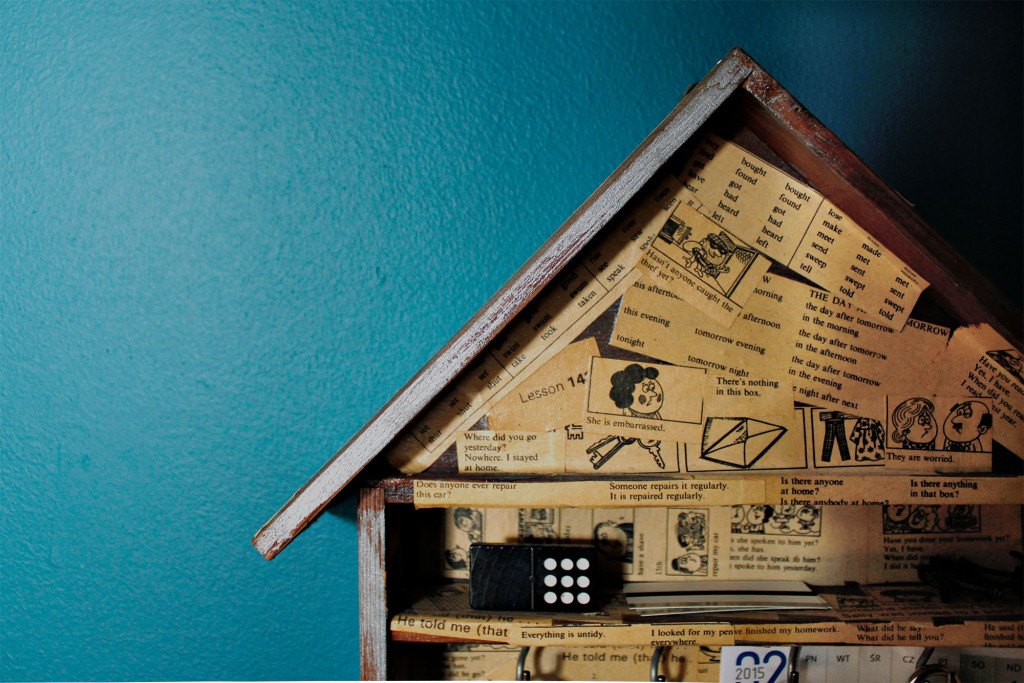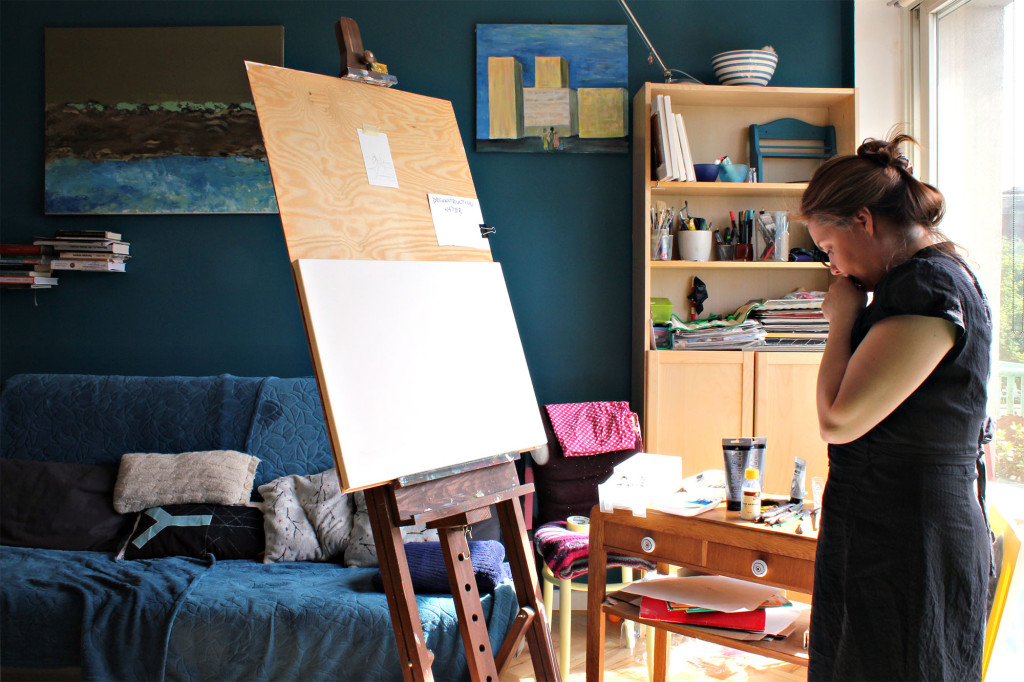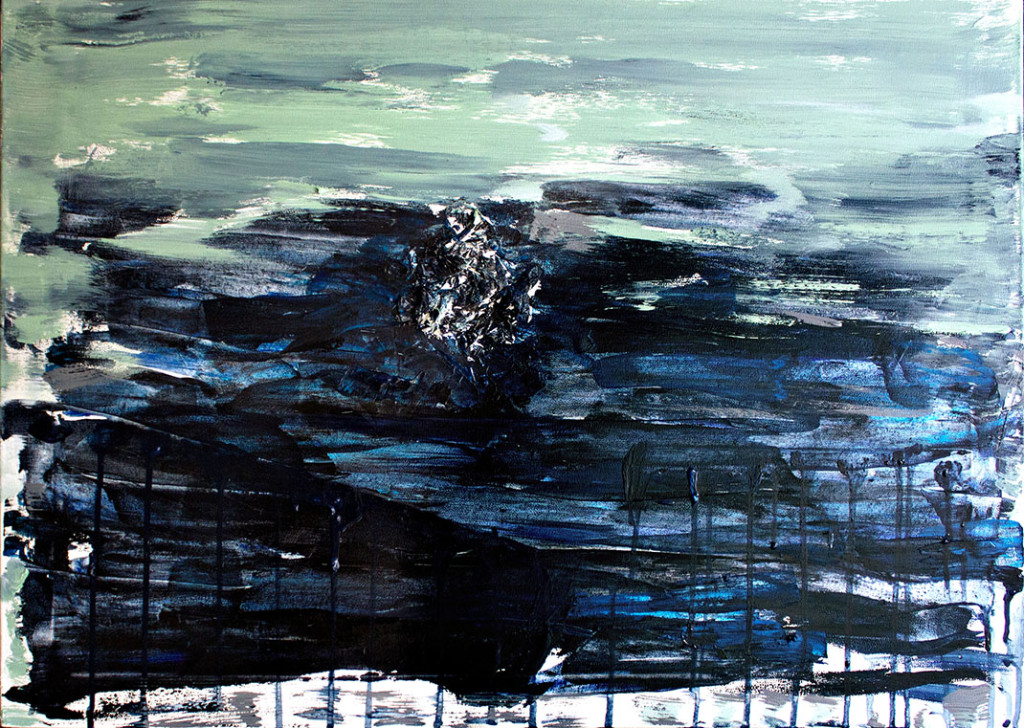|
“What I see in this, is water and deconstruction.”
Todays “domino” Marta Tamaris Tarasiuk picked me up from the metro-station and guided me to her place. A quiet and sunny spot, close to the city centre of Warsaw. Her apartment is also her working space and it is painted completely in saturated ocean green.
 No surprise, that the sea is one of her favorite things. No surprise, that the sea is one of her favorite things.
For her Bachelor degree at the University of Art Education (Instytut Edukacji Artystycznej), she made 12 abstract oil paintings within a year. In the end she realized that water appeared as a recurrent motive in all of them.
She said some people are more connected to the mountains and others are to the sea. She is a sea-person, for sure.
I showed her Hanna Kaszewskas drawings about different expressions of strength and weakness.
One of the things that Marta noticed right away, just a s I did, were the wavelike lines in some of the pictures. I explained to her that they kind of illustrate the physical and emotional relation of the body to the surrounding, whether it’s separated or blending.
Marta picked the last picture in Hannas row. “What I see in this, is water and deconstruction.” she said instinctively.
Deconstruction, because the body is dissolving. Body parts appear separately. There is no rump, no head. Just kneeled down legs and arms, held in front of a non existing chest, maybe protecting, maybe protesting, maybe sinking down.
The waved lines in fact remind of water, surrounding the body. So for Marta, it became clear that she wanted to express that moment, when something dissolves in water.
“Music gets you into a different state of mind.”
 She set up a canvas and acrylic paint. Usually she would use oil, because it can be worked with more plastically and over some time. And, because she likes the smell, of course. She set up a canvas and acrylic paint. Usually she would use oil, because it can be worked with more plastically and over some time. And, because she likes the smell, of course.
But for now she would do different, so that the painting would dry in time.
She turned on some music, first Moderat, then Atoms For Peace. She loves electronic music and she needs to have music on to paint. “I couldn’t imagine different! Music gets you into a different state of mind.”
Marta told me that she likes to paint also to relax and get away from everyday life. The subjects of her paintings are not personal in first sight. You wouldn’t find private stories in her work, “but the emotions are there”. Generally she gets inspired for example by social or public topics, like the consequences of the nuclear catastrophe in Fukishima. (One of her oil paintings shows the sea, being threatened by a toxic-looking, brown, greenish wave.)
After a moment of thinking, Marta started by attaching a crumpled piece of paper on the upper part of the canvas, to represent the moment of deconstruction. A foreign matter in what was to become the surrounding. Also she placed it there because the could see a certain kind of “emptiness” at the top of Hannas drawing as well. She pointed out to the spot where the head of the figure would have been. So she created some kind of formal connection between the pictures, by placing something, where Hanna left something out.
Marta prepared a few colors for the water-part. She started by smearing dark blue on the canvas with a palette-knife. With big gestures she put on the paint from on side to another, as if she would follow the waveforms with her body.

After some time she would sprinkle some water on the lower part to create drops, running down the surface and leaving vertical lines.
After that part was done, she chose a light mint green and put it on the top of the canvas with a brush.
She glanced at it for some moments and then decided that it was done.
We spent the rest of the day at Zachęta – National Gallery, at an exhibition called “Cannibalism?”: Pieces from artists who copied images and ideas from other artists, or used their material in different context, in a postmodern way. One of the most famous exhibits probably were Cindy Shermans film stills, copies on their own already, but being copied again by a Polish photographer. Sherman reconstructed movie sets and placed herself in the role of the female protagonist, to draw attention to idealized images of women, constructed by male movie makers, with a male gaze.
The copy of another work or the reinterpretation and development, reminded me of processes I could also discover in my project. Even if the participants are asked to react to an artwork, having a quite concrete starting point, the results can turn out as different as you can imagine, and surely receive their very own legacy.

Martas expressive, filled painting was simply the opposite of Hannas reduced, minimalistic drawings. It’s obvious to see that even by keeping up a relation between two artworks, the concept, impression and appearance can change completely.
After meeting a person who loves the sea, it was my time to actually meet the sea itself and I took Martas “marine painting” with me to Tallinn.
|
 No surprise, that the sea is one of her favorite things.
No surprise, that the sea is one of her favorite things. She set up a canvas and acrylic paint. Usually she would use oil, because it can be worked with more plastically and over some time. And, because she likes the smell, of course.
She set up a canvas and acrylic paint. Usually she would use oil, because it can be worked with more plastically and over some time. And, because she likes the smell, of course.
